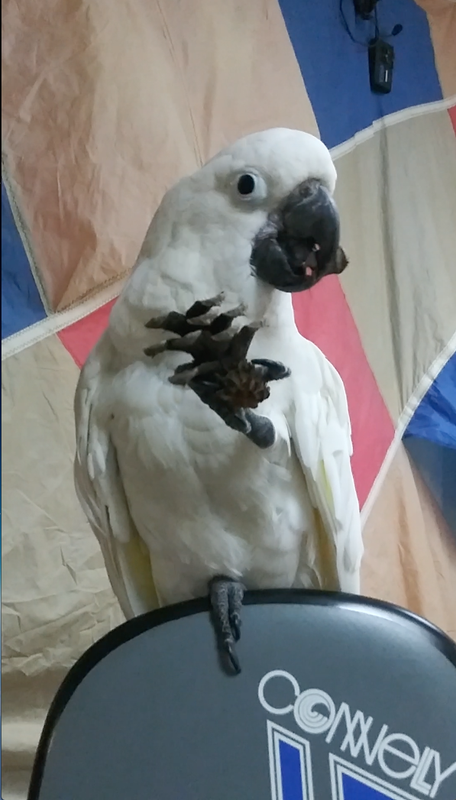Yep! That's about it in a nutshell, WhiteFlight!
We lay big sheets of cardboard on our cage floors and the two females, Madge and Rosetta, go to town, turning it all into doileys and/or confetti. The male, Barney, is above such menial labour, so he just watches and will occasionally descend and pick up a piece of shred, which he will sit and chew on meditatively for a while before dropping it on Madge's head.
I can't get near my lot with a Dremel, but found it easy enough to stick my finger out for the bird to hang onto. While they hold my finger through the cage bars, I just snip off the very tips of their nails with a nail-clipper. No drama and it gets the job done.
The local cockatoos are not terribly popular because they cause so very much destruction. They'll strip a whole street's trees bare in an afternoon, leaving tonnes of frass all over the road surface - skidding accidents - and people's yards. They'll alight on someone's roof and attack the coaxial cable that connects their TV aerial and chomp it into little pieces (no TV for weeks and a big repair bill). In rare cases, they'll alight on a parked car and relieve it of everything that sticks out: the antenna, windscreen wipers, side mirror and all rubber glass fixtures. Of course, when they come in numbers (upward of two hundred or even more in a dry year), they poo. Frequently and copiously. Cocky poo is big and green and slimy and is not your desired finish for the side lane or the front footpath. I know this is nasty, but I have seen people slip over on copious cocky crap and it can be... amusing. I know! I know! I shouldn't laugh! But just sometimes, it's good to see the birds get the upper... claw. Y'know?
A few years ago, some b*stard laid poison baits for the cockies living around Lake Macquarie (north of Sydney). About a hundred corellas were found dead and dying on the lake shore and far too many of the local people were not entirely sorry about that. They seemed to think the damage done by the birds warranted the poisoning.

It's been a pretty wet year this year, so there haven't been the megaflox of cockies that we got used to seeing during the Big Dry. I posted photos of about two hundred SC2s on my roof and more of a hundred or so corellas yahooing on the power cables. Since then, the numbers have dwindled and now we only see the odd dozen or so cockies tootling around the skies. When it's wet, the birds are able to stay more within their normal range, which is 'out west' in the grain-growing areas. They live almost entirely on cereal grain and native grass with a spot of shrubbery and grubbery thrown in.
The black cockies are entirely different. They live mostly in closed forest (ie. ones where the trees' canopies meet and form an 'umbrella' against the sun), feeding on fruits and grubs and some grass seed, which they occasionally descend from the trees to enjoy. In their usual range, they form tribes of up to fifty or so birds, but our local lot seems to fluctuate between six and twenty, depending on whether they're feeding fledgelings. We get regular visitations and they seem to come from a local closed-forest association called 'Nannygoat Hill' ('bout a mile away from where I live).
Whenever anyone in the house hears the black cockies' cry, they'll shout out and all four of us rush out to see. There might be one or two, or there might be twelve or more, but however many there might be, we want to see them! The Yellow-tailed Black Cockatoo is a magnificently large bird, longer than an SC2 but much lighter and longer of tail. They fly with slow, deliberate wing-beats and call plaintively to one another while doing so, presumably keeping in touch 'just in case'. They'll alight in a tall tree (won't go down into anything less than three metres high - wisely!) and begin to chomp. They might stay for ten minutes, or they might stay for a couple of hours. While they're there, they moan and groan and wheeze with a raspy sort of cry which, to my mind, shows pleasure.
Once, we were lucky to have a Mum'n'Dad and their baby in our big lemon gum (nine metres). The flock had come to enjoy the spring blossoms which are loaded with nectar. Honestly, the sound of a baby YTBC begging for food is not something you'd want to hear for very long! It's *so* insistent and the poor parents nearly went spare, taking turns to vom for their importunate child. Of course, my family and I were in fits of joy, watching all this from the back deck. They were close enough that I could easily make out the yellow scalloped edges of their breast feathers! Then, as one, the whole flock simply rose into the sky and wheeled off to land in a pine tree about a hundred yards away. I LOVE them!
We get other visitors to our yard as well: Eastern and Crimson Rosellas, various Grass Parrots (Neophema) and very occasionally a couple of King Parrots. Oh and the Lorikeets of course. The Rainbows are a fixture and come every day in hordes to strip the gum blossoms and new shoots off the trees. This year, we also had Musk and Little Lorikeets visiting in good numbers (over a hundred), so that was exciting as well.
It's the cockies, though, that have my heart. There's just something about them, isn't there?



